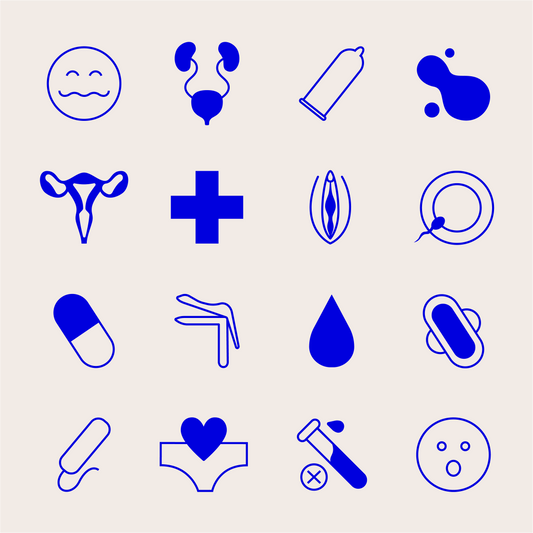Alexandra Fine, Credentialed Sexologist, M. Psych | Written by Dame
Internal Erogenous Zones | What Is the A-Spot? | How to Find the A-Spot | The Importance of the A-Spot
Ponce de Leon never discovered the Fountain of Youth. The knights of King Arthur’s Court never found the Holy Grail. No one’s ever been able to find Jimmy Hoffa’s body, or the site of Amelia Earhart’s plane crash, or Cleopatra’s tomb, or the fabled “lost city” of Atlantis.
Those quests all pale in comparison, though, to the difficult search that vulva-havers and their partners have undertaken over the years: the search for the elusive G-spot.
The G-spot (full name: Gräfenberg Spot) is located deep inside the vagina, along the vaginal wall. And it’s credited with being able to produce powerful climaxes – at least, for those who are able to find and stimulate it.
If your search has been successful and you’ve experienced (or have helped a partner experience) a G-spot orgasm, good work!
But don’t rest easy just yet. Have you been able to find the A-spot?
Yes, there is another pleasure center for vulva owners and their partners to discover. But don’t think of the A-spot as simply the objective of another frustrating – and possibly fruitless – search.
Instead, consider it another potential source of great pleasure, which can be well worth finding. That is, if it really even exists. Not all experts believe that it does.
Internal Erogenous Zones: Are They Real?
The “discovery” of the A-spot only came a few decades ago, and its existence is far from universally accepted.
That’s not surprising. Many of the mechanisms leading to sexual satisfaction, particularly when they involve internal sexual organs, are so complicated that researchers’ conclusions often remain in dispute for years or even decades.
The G-spot is a great example.
German gynecologist Ernst Gräfenberg, the inventor of the IUD (the intra-uterine birth control device), was also the first to research and write about the G-spot back in the 1950s. However, his work received little attention at the time.
This supposedly magical “spot” on the vaginal wall earned a permanent place in popular culture in the early 1980s, with the publication of the international best-seller The G Spot and Other Recent Discoveries About Human Sexuality by sexologist Beverly Whipple Ph.D. and two colleagues. They were the ones who coined the term G-spot, which they named after Gräfenberg.
For the next thirty years, much of the medical world disregarded, or even ridiculed, the concept of the G-spot. And those who did believe in the existence of an erogenous zone along the vaginal wall relied primarily on anecdotal evidence, without anatomical proof. It wasn’t until 2012 that Florida researchers dissected the vaginal walls of eight cadavers and documented the existence of the G-spot.
The G-spot has finally been proven “real” to a majority of researchers and doctors. Despite the anatomical evidence, however, there remain a number of skeptics (led by Italian physician Vincenzo Puppo) who still insist there’s no such thing as the G-spot.
What does this all have to do with the A-spot?
Here’s the bottom line: since the existence of the G-spot is still being argued years after it’s been documented as real – it’s not at all surprising that the lesser-known A-spot is a controversial subject.
Here’s what we know so far.
What Is the A-Spot?
“A-spot” is the shorthand used to describe the area of the vagina known as the anterior fornix erogenous zone.
(Some people incorrectly call the A-spot the “female prostate,” because it’s located in the same general anatomical area as the “male prostate.” In reality, vulva-havers’ Skene’s glands are the true homologues of the prostate, and they’re believed largely responsible for “female ejaculation.”)
The A-spot is a patch of tissue located deep inside the vagina, on the front (anterior) wall adjacent to the bladder and the cervix. The “A” is short for anterior, but some people insist that it really refers to “anal” – since one way to stimulate the A-spot is through the anus. The more formally-named AFE zone was first identified by the Malaysian researcher Dr. Chua Chee Ann in 1997, while studying problems experienced by vulva owners who had difficulty reaching climax.
Perhaps the most surprising fact about the A-spot: it’s apparently a part of the clitoris. That’s less surprising once you know that most of the clitoris is actually inside the body; the small, sensitive “pleasure point” that most of us call the clitoris is really the glans clitoris, the only external portion of a much larger structure which extends well into the body. In fact, the glans clitoris makes up less than one-fifth of the entire clitoris.
Why does hitting the A-spot feel so good? One reason, as documented by Dr. Chua, is that stimulating the sensitive tissues of the AFE zone leads to the generation of vaginal lubrication. Needless to say, anything that eliminates vaginal dryness makes foreplay and penetration (with sex toys or a penis) more enjoyable.
Second, stimulating the sensitive A-spot tissues means that you’re also stimulating the entire clitoris. Those extremely pleasurable sensations are transmitted throughout the vulva, heightening sexual pleasure and making orgasms stronger.
There’s one major area of dispute. Some people with vulvas say they’re able to enjoy strong orgasms simply through stimulation of the A-spot – and that it can produce multiple climaxes as well. But as far as sexologists and researchers know, there’s no proof that a standalone “A-spot orgasm” exists.
Either way, A-spot stimulation makes the process of reaching climax easier, more intense, and felt more deeply throughout the vulva. And some sex experts and therapists believe that contact with the A-spot explains why deep penetration can trigger strong vaginal orgasms in some lucky vulva owners.
How to Find the A-Spot
If you obsessed over finding the G-spot when you heard of its existence, we have good news and bad news.
The bad news? Discovering the A-spot requires an entirely new search. The good news? The search process is exactly the same, so you should already know how to go about it. And of course, there’s more good news: finding the A-spot is well worth the effort.
There are two “landmarks” inside the vagina which should help guide you on your new search.
- One is the G-spot (assuming you’ve previously found it). The A-spot is on the same “front wall” of the vagina, the one closer to the belly button, but about two inches deeper than the G-spot.
- The second landmark is the cervix, the circular “doorway” at the very end of the vaginal canal.
The easiest way to explore is with your fingers. Start at the cervix, and move them forward along the vaginal wall in the direction of the G-spot. You’ll quickly arrive at the spongy tissue known as the anterior fornix erogenous zone, or A-spot. The tissue is much more sensitive to pressure than it is to touch, so be sure to press gently as you explore – or you might pass right over the A-spot without realizing it.
It’s important to remember that everyone’s body is built differently and reacts differently. Not all vulva-havers will find that stimulating the A-spot is pleasurable; some will not react very much at all, while others may find the area much too sensitive for prolonged contact.
Chances are good, though, that even a small amount of A-spot stimulation will produce a noticeable increase in lubrication and a definite increase in sexual pleasure. (That’s only true under the right circumstances, of course. Don’t expect the same results if a doctor brushes against your A-spot during a gyno visit.)
While fingers are the best “tool” to use when first searching for the A-spot, there are many ways to reap the benefits once you’ve found it.
How to Pleasure the A-Spot
To restate something we mentioned earlier: there are plenty of anecdotal reports from vulva owners who say they’ve climaxed just from massaging the AFE zone, but there is no scientific or medical evidence proving the existence of A-spot orgasms.
In other words, stimulating the A-spot is likely to produce the most satisfaction when combined with other sexual activities. One option is to consider A-spot stimulation an element of foreplay, increasing vaginal lubrication and heightening sensitivity throughout the vulva. Another approach is to pleasure the A-spot while simultaneously enjoying clitoral stimulation or other types of sex play.
Here are some of the A-spot stimulation techniques and positions you can try.
Fingers
Reaching the A-spot requires deep penetration, so not everyone’s fingers are long enough to comfortably stimulate the area. It’s definitely worth taking a shot, though.
- For solo masturbation, use whichever position allows you the greatest access and widest range of motion. Insert several fingers (the index and middle fingers are usually the longest) with your palm facing up and your fingers curved toward your belly, and massage the A-spot with up-and-down and back-and-forth motions.
- The best position for A-spot partner play is doggy-style, because it allows deep penetration. In this case, the partner’s palm should be facing down with their fingers curved downward.
The same advice on positions can be followed when you use sex toys to hit the A-spot.
Toys
Both dildos and vibrators can be used to stimulate the A-spot, and a G-spot sex toy is the best choice because it’s long and curved at the tip. A few companies do sell toys supposedly designed to hit the A-spot; in reality, they’re selling toys made for G-spot stimulation which have simply been re-labeled for marketing purposes. Don’t pay extra for an “A-spot” sex toy. The G-spot one will work just fine.
Vibrators aren’t always a better choice than non-vibrating wands. Many people find their A-spot is so sensitive that the vibrations from a powered sex toy are way too much to handle. It might be smart to start with a G-spot wand (like the nJoy Pure Wand), and only try a vibe once you know how you respond to A-spot stimulation.
Vaginal Penetration
You know your bodies (yours and your partner’s) better than we do. So the best sexual positions for stimulation of the A-spot are the ones that work best for you.
Among those to consider:
- Missionary: This isn’t optimal for most people, since deep penetration can be difficult to achieve while in the missionary position. It might help, though, to place a few pillows under the hips of the partner whose A-spot is being stimulated. That will optimize the angle of the vaginal canal and make contact with the A-spot easier.
- Doggy: It’s a good choice for deep penetration, and chances of stimulating the A-spot are increased when the “giver” is positioned higher than the “receiver.” That will make contact with the front vaginal wall more likely.
- Cowgirl or Reverse Cowgirl: The “receiver’s” position on top generally creates deep penetration, along with the ability to adjust their body to allow maximum contact with the A-spot.
- “69” position: When the A-spot owner lies on top of the penetrator, face down and facing away, that’s another way to enjoy deep penetration and optimize contact with the AFE zone.
Anal Sex
Anal penetration can produce mind-blowing orgasms in penis-havers, thanks to the proximity of the rectum to the prostate gland (and the thousands of nerve endings it contains).
Anal sex provides quite a different experience for cisgender women and those assigned female at birth, since they don’t have prostates. However, vulva owners don’t need a prostate to enjoy back-door sex play. The anus contains a huge number of sensitive nerve endings – and anal penetration can indirectly stimulate both the G-spot and the A-spot, through contact with the thin vaginal wall which separates the rectum from the vagina.
This is best accomplished by using the rear-entry missionary position. The majority of vulva-havers reportedly don’t climax from anal sex alone, but this position allows them to massage their clitoris while also enjoying indirect stimulation of the A-spot from behind.
Oh – be sure to always use plenty of lube. Rectal tissues tear easily, and the anus doesn’t produce any lubrication on its own.
The Importance of the A-Spot
Humans had plenty of terrific sex for millennia before anyone had heard of the A-spot, and it’s certainly not the only sensitive area on (or inside) the body. There are dozens of erogenous zones ripe for sexual stimulation, including many in the genital region and five located deep inside the vagina. (The others are the G-spot, the cervix, the O-spot (located behind the cervix), and the pelvic floor muscles; as a group that includes the A-spot, they’re referred to as the deep vaginal erogenous zone.)
Even so, finding the A-spot can make sex play even better since, as the TV public service announcements say, “The More You Know.” Knowledge is the true secret to sexual health, wellness – and enjoyment.
Finding and stimulating the A-spot may not produce a shattering orgasm all by itself. But it’s an erogenous zone that’s worth discovering, because it can allow you to enjoy even more sexual pleasure than ever.





























